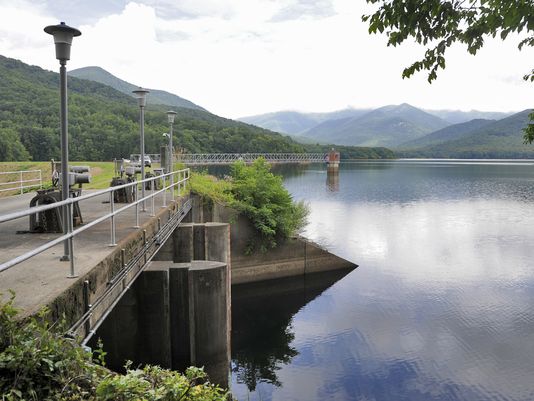While Buncombe County is experiencing drought this summer, Asheville’s water supply remains ample. To be sure levels at the North Fork Reservoir have dropped somewhat. But it’s a deep dish that can hold a lot of liquid, and this allows Asheville to delay mandated conservation in all but the most extreme conditions.
“We get asked during periods of drought when we will start conservation,” said Asheville Water Resources Director Jade Dundas. “Right now we’re monitoring the lake levels and they are dropping. Even so, there’s quite a bit of room left before we enact even voluntary conservation.”
Recent rains have helped ratchet back the overall deficit, though according to the National Weather Service, rainfall totals in Asheville are still around 4½ inches below normal for the year. Buncombe is one of nine North Carolina counties classified as in severe drought.
Asheville has three treatment plants. Two of the plants have reservoirs and the third receives water from a river intake. The water supply for the three plants are all within protected watersheds.
The North Fork and Bee Tree reservoirs lie within 22,000 acres of protected watershed. No recreation is allowed on these lands, ensuring the source remains pristine. “So the water is phenomenal,” said Dundas. “Asheville’s system is very reliable.”
“Asheville’s water system was very well planned out from the beginning,” Dundas noted. “That doesn’t mean we won’t have times we have to conserve.”
Fortunately, Asheville has not had to issue mandatory water conservation since 1998.
“In 1999 the Mills River treatment plant came online, so that is an additional supply source not available during 1998.” Dundas said. Mills River provides the City with an extra source of water and, if situation warrants, the Mills River plant has the option of withdrawing from French Broad River, providing additional water availability although this is reserved for only extreme cases.
The City has a process in place, a stepped system of conservation determining when restrictions should go into effect. Voluntary conservation is the first step of course, to be followed by mandatory restrictions, mandatory with surcharges in only the most severe of situations.
Water Resources staff run a predictive drought model based on lake levels, precipitation and 90 years of historical data. This gives Water Resources an outlook for what’s ahead. Water Resources crews are also monitoring for system leaks as part of being good stewards of our valued resource. The non-revenue water program is a comprehensive system assessment intended to minimize water lost from the system through leaks and others areas. Water loss is a challenge in Asheville due to the age of the system and the mountainous terrain.
“The 10-week outlook shows the Asheville water system to be in good shape,” Dundas said. “At this point in time it doesn’t appear there will be a need for conversation.” The department is keeping a close watch on water levels at the lakes. Despite the drought conditions the City and still promotes a philosophy of smart water use, both for itself and its customers.
Steps to promote water conservation in your home can include:
- Checking pipes, faucets and toilets for leaks. Fix them promptly when found.
- Install water-saving shower heads and low-flow faucet aerators.
- Take shorter showers.
- Turn off the faucet after you wet your toothbrush.
- Plant a drought-tolerant landscape that will need little watering.
- Wash only full loads of dishes and laundry.
